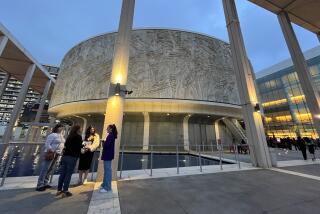Taking note of a wave of shorter plays
As artistic director of L.A.’s Center Theatre Group, Michael Ritchie reads more than a play a day on average — perhaps 500 a year — in quest of the 15 or 16 he’ll pick each season for his company’s three stages.
But lately he’s noticed that there’s a bit less to read. Shorter scripts have been popping up more than they used to.
“Nowadays a lot more plays are being written as one-acts,” said Ritchie — meaning the stories play out in perhaps 90 minutes or less, without stopping for intermission. “As we all know, things are moving faster and being delivered faster to everybody, universally,” and he thinks it may be a matter of playwrights soaking up how society moves around them.
PHOTOS: Arts and culture pictures by the Times
But Ritchie and several other theater leaders who’ve noticed more intermissionless plays in the mix are not about to add a stopwatch to their play-picking apparatus, nor do they worry that an infusion of shorter plays means impending doom for stories that unfold over two hours and call for a pause in the middle.
“In any given season, I’m pretty much running the range, depth-wise, style-wise and period-wise,” Ritchie said. “A well-made play is a well-made play, regardless of its length,” and he and others interviewed for this story are not concerned that an influx of leaner scripts means a thinner experience for playgoers.
First, concise, intermissionless plays are nothing new. Most of the ancient Athenian tragedies that gave birth to the theater more than 2,400 years ago take about 90 minutes to perform.
What matters, Ritchie said, isn’t how much time goes by but whether it flies.
Earlier this year, at the Goodman Theatre in Chicago, he saw Eugene O’Neill’s “The Iceman Cometh,” with Nathan Lane and Brian Dennehy. It had three intermissions. “It didn’t feel like five hours to me — it felt like two hours.”
Conversely, he said, he didn’t think twice about charging full fare recently for a theater evening at the Kirk Douglas Theatre that clocked in at just 55 minutes. John Hurt performing Samuel Beckett’s one-character play, “Krapp’s Last Tape,” may have been the shortest program ever offered by a major Los Angeles company.
“My feeling was John Hurt and this play is a full evening of theater, and we had no negative feedback at all from our audience,” Ritchie said. Many wanted the experience to linger, and were able to satisfy that by joining after-show discussions in the lobby after each performance.
Los Angeles Times critics note a play’s running time at the end of their reviews, permitting an unscientific pulse-taking of what’s happened to play lengths over time. In September and October 1997, 15% of the plays reviewed ran 95 minutes or less. For the same two months in 2012, it was 37%. The inverse was true for plays running 21/2 hours or more: 33% in 1997, 16% in 2012.
Bart DeLorenzo, a veteran L.A.-based stage director who tackles new plays such as Donald Margulies’ “A Coney Island Christmas,” expected to run about 85 minutes when it opens this week at the Geffen Playhouse, and classics such as the 2-hour, 40-minute staging of Shakespeare’s “Cymbeline” that closed recently at A Noise Within in Pasadena, said the rise of the intermissionless play dawned on him in 2009, when four consecutive shows he directed ran 60 to 70 minutes, without intermission.
“From my own experience, I hear from audiences that they appreciate a short play,” said DeLorenzo, who programmed the Evidence Room theater near downtown L.A. for 11 years until 2007. “It gives them an opportunity to go have a drink afterward or talk with their friends instead of being the whole evening. I don’t know if most playwrights let the audience drive them, but one is always aware of that.”
DeLorenzo speculated that the success of several prominent intermissionless plays in the early to mid-1990s — John Guare’s “Six Degrees of Separation” and Paula Vogel’s “The Baltimore Waltz” and “How I Learned to Drive” — may have paved the way for others to give it a try more often.
Guare chuckled at the suggestion that he may have dealt a blow to sales of candy bars, cookies, coffee and alcohol during theater intervals. “I wish I could take credit for it.”
He recalled Murray Schisgal’s 1964 comedy, “Luv,” as the first Broadway play he saw that dispensed with an intermission and noted that even “A Chorus Line,” which bowed in 1975 and became one of the longest-running shows in Broadway history, didn’t beget a wave of other musicals that followed its intermissionless lead.
“I can’t tell you how few conversations I’ve had” with fellow playwrights about whether to include an intermission, said Guare, who has written his share of longer plays, including “Bosoms and Neglect” and “The House of Blue Leaves.”
For “Six Degrees of Separation,” he said, it was the story he wanted to tell rather than any concern about the running time that prompted him to specify that it should play at hurtling speed and without a break.
“I don’t think you can draw any hard and fast conclusions as to what running time means,” Guare said in a follow-up email. “I’ve just come from [the Broadway revival of] ‘Who’s Afraid of Virginia Woolf?,’ which clocks in at three hours with two intermissions, and the audience couldn’t have been happier.”
Guare says playwrights’ chief worry is not producers keeping an eye on the clock but on the bottom line. “Today’s main problem is not running time but most producers’ reluctance to produce a play with more than five characters. Four is better … two is best, provided they’re both stars. And one big star would be perfect. That’s what calls the shots today.”
Travis Preston, a stage director and dean of the school of theater at California Institute of the Arts in Valencia, says there’s definitely something in the air about the advisability of keeping things short. “There’s a lot of conventional wisdom that’s seemingly dictating choices about duration — a perspective that’s almost unchallenged in certain theater circles that a contemporary audience has a shorter attention span because the quick delivery of information has become a staple of our lifestyle. There is concern about ‘keep it moving, keep it fast, it needs to pop, it needs to stay exciting.’”
Preston doesn’t exempt himself: When he staged Henrik Ibsen’s “The Master Builder” in London in 2010, a concern with speed and attention spans played into his decision to skip the traditional intermission and stage it in 105 minutes without a break.
But he doesn’t think that speed-consciousness threatens excellence. “Different periods in history have had different concerns. I don’t see anything untoward or dangerous in it. I think artists continue to write things with the duration it should be.”
Like Preston, Julia Rodriguez-Elliott, producing artistic director of A Noise Within, says she sometimes struggles with a ticking internal timepiece that tells her, “if you don’t go faster you’re going to somehow lose [the audience’s] attention.” But she manages to remind herself that some passages in a play just need to breathe.
A Noise Within is devoted to classic stories — half-century-old plays by Arthur Miller and Tennessee Williams would be among its seasons’ newer offerings — and, ancient Greeks notwithstanding, they tend to run beyond two hours. But Rodriguez-Elliott says that judging from the company’s frequent performances for high school and middle school audiences — with no cuts from what the general audience sees — fears about dwindling attention spans may be exaggerated.
“My sense is they might be slightly more engaged” than their peers from 20 years ago, she said. Perhaps minds bombarded by electronic prompts and digital stimuli welcome the chance to settle in for a spell with something that can’t be summoned or dismissed with strokes on a keypad or touch screen.
“They crave being in this world where they’re getting a different experience,” Rodriguez-Elliott said. “It all comes down to the content. Is it compelling to them or not?”
MORE
INTERACTIVE: Christopher Hawthorne’s On the Boulevards
TIMELINE: John Cage’s Los Angeles
PHOTOS: Arts and culture in pictures
More to Read
The biggest entertainment stories
Get our big stories about Hollywood, film, television, music, arts, culture and more right in your inbox as soon as they publish.
You may occasionally receive promotional content from the Los Angeles Times.







